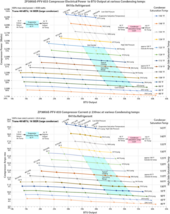Hi everyone,
Just a thought question. I had been reading up on wind turbines and was wondering if anyone had considered attaching a wind turbine to an outdoor heat pump or AC unit? These units produce a lot of "wind" when running and a narrow turbine or blade attached to the front of the heat pump or top of the AC condenser could make use of this. In a way, this would be similar to regenerative braking in EVs. Any thoughts? My main thoughts are space to accommodate the turbine, and if this would put any extra load on the fan of the units. Just wanted to see what others though. Obviously this is just a thought experiment but welcome any feedback. Thanks
Just a thought question. I had been reading up on wind turbines and was wondering if anyone had considered attaching a wind turbine to an outdoor heat pump or AC unit? These units produce a lot of "wind" when running and a narrow turbine or blade attached to the front of the heat pump or top of the AC condenser could make use of this. In a way, this would be similar to regenerative braking in EVs. Any thoughts? My main thoughts are space to accommodate the turbine, and if this would put any extra load on the fan of the units. Just wanted to see what others though. Obviously this is just a thought experiment but welcome any feedback. Thanks






